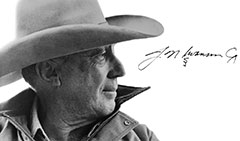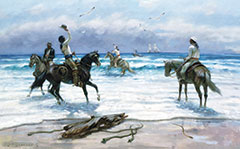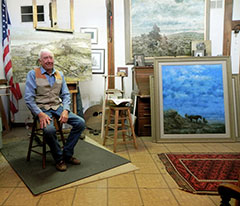JN Swanson Paintings

J.N. Swanson
1927 – 2014

Jack Swanson was born in 1927 in Duluth, Minnesota to Margaret and Leonard Swanson. The family moved frequently during the Great Depression, and in 1942 came to Oakland, California. Teen-aged Jack headed south to work on at the Dry Creek Ranch, 10,000 acres of rolling San Joaquin rangeland. The owner, 90-year old I.L Borden was a rawhide-classic, impeccably dressed, with a black patch over one eye. “We got nothing but horses here son, and we could use some help,” he told Jack. The young Swanson soaked up the experience like a sponge. In 1944, he turned seventeen and the Second World War had taken many of the young men who worked the ranches so he was able to find work. His feeling of freedom was overwhelming. It was at a time when a cowboy could still ride almost anywhere in California and he took jobs across the Mojave and up into the Tehachapis. The old vaqueros he met along the way were happy to find someone able and willing to work.
It was a magic period for the young cowboy. It was about this time when he met a vaquero that would change his life. Frank Martinez was head “horse breaker” with the huge Miller & Lux Ranch at their horse camp near Buttonwillow in the lower San Joaquin. Martinez would teach the young cowboy much and that time with the old vaquero was, in Jack’s words, “Unforgettable and priceless.”
When Jack left the Tehachapis and made the long ride home horseback across the state, he had already signed up for the Navy. He was stationed on hospital ships until his enlistment was up, and after the war, attended the California College of Arts and Crafts on the G.I. Bill. Jack knew exactly what he wanted out of an art school, and didn’t find it there. He hit the road with his horse Amigo and made some money running match races with the fleet footed quarter horse. They rode into Carmel in 1949, where he and Amigo shared a stall at the Hodges stable near the Carmel Mission.

He was soon discovered by Carmel icon Lloyd Tevis and his man Friday, Major Morgan. The two taught the young man the pleasures of a well-told story, strong whiskey, and freshly baked bread. Donald Teague, Armin Hanson, John O’Shea and a cadre of early California artists invited him into their studios and homes to swap stories long in the night. Jack enrolled in the small Carmel Art Institute, and it was there that he met and soon married his wife Sally, giving her his horse when he proposed to ensure a yes. The couple soon became a part of the Carmel art scene, becoming lifelong friends with artists Steve Crouch, Eldon Dedini, Gus Ariola, Ann and Gene Baker, Frank and Betty O’Neal, Feg Murray and many others. In 1956 Jack and Sally bought land from Ann and Fred Nason in Cachagua, and built what would become Whiffletree Ranch, trading paintings for lumber and building the ranch themselves. Jack’s reputation as an artist who depicted the vaqueros of the Pacific Slope grew. His subject rode from the vast rangelands of Nevada and eastern Oregon to the pastoral oak-covered hills of California, and in 1967, Jack became one of the first members of the prestigious Cowboy Artists of America. His work has been exhibited in major museums, the California Governors mansion, the White House, and is a part of numerous private and corporate collections.
